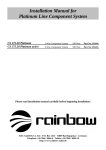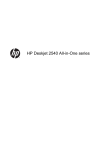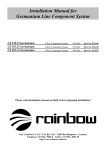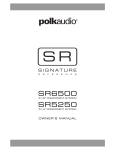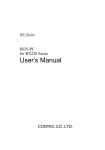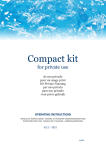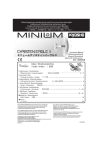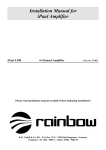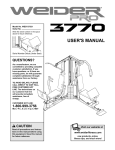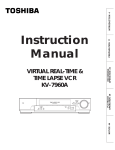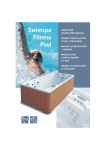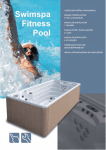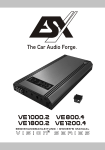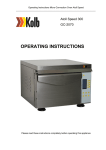Download Installation Manual for Platinum Line Component System
Transcript
Installation Manual for Platinum Line Component System CS 275.28 Platinum CS 275.28 Platinum active 2-Way Component System 180 Watt Part No. 231444 2-Way Component System 180 Watt Part No. 231445 Please read installation manual carefully before beginning installation! RAC GmbH & Co. KG - P.O. Box 1225 - 74899 Bad Rappenau - Germany Telephone +49-7066 / 9006 0 - Telefax +49-7066 / 9006 50 http://www.rainbow-audio.de Important Safety Instructions Please read all warnings found in this manual. They inform you of the potential danger of personal injury or damage to property. Our products are intended for use only by those possessing the necessary specialized knowledge. The relevant safety regulations regarding related auto parts, the regulations on internal vehicle safety, as well as the regulations of the authorized vehicle manufacturers should be followed diligently. Hearing Damage ContinualContinuous, excessive exposure to sound pressure levels in excess of 85 dB can cause a loss of hearing. Rainbow® components are capable of producing sound pressure levels greater than 85 dB. Volume and Driver Awareness Use of sound components can impair your ability to hear necessary traffic sounds and may constitute a hazard while driving your automobile. Rainbow® accepts no liability for hearing loss, bodily injury or property damage as a result of use or misuse of this product. Working on Automobile Do not use your automobile until all components of the loudspeaker system have been secured to the interior framework. Failure to do so may turn a component into a dangerous, flying projectile object during a sudden stop or accident. Do not drill or drive screws through any vehicle interior or carpeted floor before inspecting the underside for potential punctures to control lines or cables. Be sure to avoid all fuel lines, brake lines, electrical cable, and or oil lines when planning the installation. Before beginning installation of the loudspeaker system remove the minus connector (-) from the automobile battery in order to avoid possible short circuits. Use care when removing interior trim panels. Car manufacturers use a variety of fastening devices that can be damaged in the disassembly process. If sheet metal must be cut or removed contact your authorized car dealer for professional advice. DamageBy damage to supporting body structure may result instructures the safety permit beingcertificate may be withdrawn. ! Shock Hazard ! Do not touch the connectors when the system is running! 2 Table of Contents Important Safety Instructions Table of Contents Important Operational Information Contents and Detail of Parts Technical Data Platinum Line Capabilities Positioning the Loudspeaker Installing and Attaching the Woofer Installing and Attaching the Tweeter Clamp ring flugh mount installation Angle mount installation U-bracket flush mount installation Cable Preparation The Crossover Philosophy of the Crossover Connecting the crossover Possible Wiring Methods Tweeter terminals Woofer terminals Crossover connections Attaching the Crossover Maintenance 3 3 4 4 5 6 6 6 9 9 10 10 10 10 11 11 11 12 12 13 13 13 15 16 Figure 1 Figure 2 Figure 3 Figure 4 Figure 5 Figure 6 Figure 7 Figure 8 Figure 9 Dear valued customer, We congratulate you on your purchase of our superior product and thank you for placing your trust in Rainbow®. We have put together this installation manual with great consideration of different mechanical and acoustical auto features. Nevertheless, mistakes can happen. We would greatly appreciate your bringing any mistakes you come across to our attention. Please review the list at hand (page 4) of the complete system components to ensure against missing or damaged equipment and notify your dealer immediately of any problems. Your dealer will provide you with any necessary replacement parts and assistance you may require. Best wishes, Your Rainbow Team 3 Attention: Important Operational Information. Please Read Before Installation. • • • • • • • The loudspeaker may be operated only with the system-synchronized crossover and under observance of the specified rated output power. Interchanging the woofer and tweeter connections will lead to immediate destruction of the tweeter. Beginning operation without the crossover, for example with an active crossover or non-system crossover, may result in damage to the loudspeaker. When connecting the loudspeaker, crossover, and amplifier it is absolutely necessary to employ the same polarity. Interchanging the polarity produces an unnatural sound lacking bass reproduction. The component systems are acoustically synchronized as one unit. Supplementation through an auxiliary loudspeaker or trade out with a larger woofer is not possible as this would change the overall frequency response or impedance of the system. An overload of the crossover or a single loudspeaker would then be unavoidable. The opening of the crossover for the purpose of altering the parts or function is considered foreign interference and grounds for termination of the warranty For the purpose of technical safety, the loudspeaker should only be attached with the included self-tapping screws. We accept no liability for use of alternative methods of attachment. Contents and Detail of Parts Fastening for Woofer: 2 pieces 2 pieces 8 pieces 8 pieces 8 pieces 8 pieces 8 pieces Grill, 175 mm ∅ metal, grey with Rainbow logo Woofer, 175 mm ∅ Self-tapping screw, 4.0 x 30 V2A stainless steel pan head Washer, M4 V2A stainless steel Screw, M4.0 x 30 V2A, stainless steel Nut, M4 stainless steel Self-locking nut, M4 stainless steel A B G H C D E Fastening for Tweeter: 2 pieces 2 pieces 2 pieces 2 pieces 6 pieces 2 pieces 2 pieces 2 pieces 2 pieces 1 piece CAL 28 Platinum (volume silk dome tweeter with neodymium motor) Angle mount Threaded bolt, M4 to M5 Clamp rings Set screws Nut, M5 Screw, M4.0 x 5 Washer, M4 stainless steel Washer, M5 stainless steel Allen wrench, 1.5 J M Q R S T U V W Fastening for Crossover: 2 pieces 6 pieces 1 piece 1 piece Crossover Self-tapping screw, Allen wrench 2.0 Allen wrench 4.0 3.9 x 32 DIN 7982 Miscellaneous: 1 piece Installation manual 4 X Z Technical Data System CS 275.28 Platinum Peak power handling Power rating Sensitivity Frequency response Impedance Crossover Slope Crossover frequency Thermal protection 180 W 120 W 90 dB 1W/1m 35– 26.000 Hz 4Ω 2-Way 2 x 24 dB / Octave 2.200 Hz HALO / PTC Woofer Peak power handling Power rating Sensitivity Frequency response Impedance Recommended low-pass settings W 175 Platinum 180 W 120 W 90 dB 1W/1m 35– 5.000 Hz 4Ω 2.600 Hz with 12 dB / Oct. 2.400 Hz with 18 dB / Oct. 2.200 Hz with 24 dB / Oct. Woofer Measurements Mounting depth without / with ring External diameter without / with ring Installation diameter Fastening diameter 82 mm 180 mm 144 mm 168 mm Woofer Thiele-Small Parameter Resonance frequency DC resistance Impedance Qms Qes Qts Vas Mms BL-Factor Linear excursion (Xmax) 44 Hz 3,6 Ω 5,2 Ω @ 1000 Hz 7,15 0,41 0,39 15 litres 20 grams 7,0 Tesla-M ± 8 mm Tweeter Peak power handling (with high-pass only!) Power rating (with high-pass only!) Sensitivity Frequency response Impedance Recommended high-pass settings Tweeter Measurement Mounting depth External diameter Fastening diameter CAL 28 Platinum 180 W 120 W 90 dB 1W/1m 900 – 26.000 Hz 4Ω 2.600 Hz with 12 dB / Oct. 2.400 Hz with 18 dB / Oct. 2.200 Hz with 24 dB / Oct. 32 mm 56 mm 48 mm 5 Important: The loudspeakers may only be operated with the indicated nominal power and only with the recommended high-pass and low-pass frequencies and slopes. Any operation with frequencies and slopes other than those recommended may cause damage to the loudspeakers. Do not mix the frequencies and slopes; always use the same frequency and slope for the tweeters and woofers! You must calibrate the amplifier’s output power so that at the highest possible volume level the tweeter’s peak power never exceeds 10 Watts! Make sure of this before connecting the tweeters to the amplifier. This important information is for active operation only! Platinum Line Capabilities Rainbow Platinum Line loudspeakers are high-quality car audio systems that can be used with any commercial amplifier. For optimal sound reproduction in the vehicle we recommend the use of a linear amplifier with at least 50 Watts (RMS) of power. The excellent efficiency of the loudspeakers makes possible an enormous dynamic range, which is fully appreciable even at the minimum performance levels. Auto-specific tuning and the usage of select parts in the crossovers are characteristics that define our Platinum Line. Thermal protection, level adjustment within the high tone and bass tone range as well as changing filter slopes are just as standard as the fundamental 24 dB coupling of the individual loudspeakers. Positioning the Loudspeaker Rainbow loudspeakers may be installed in your vehicle in a variety of places. In determining the installation location the following information should be considered: • The position of the speakers has a decisive impact on both the sound reproduction and the sound impression. Moreover, you must determine whether you want to install a full-range system without subwoofers, or if you prefer a satellite system with a subwoofer as the front main system. • The Platinum system may be installed in one of the three ways: o o o • Full-range system with defined volumes Satellite system with defined volumes Standard installation for undefined door volumes The Platinum system should not be installed in the rear of the car with the trunk/boot serving as a resonance body if the required volumes are excessive. Full-range System The full-range system needs a defined sealed minimum volume. The Thiele-Small-Parameter Qts should be around 0.4-0.55 in this option. The necessary volume equals about 15 to 30 litres. For operation with high-pass / subsonic filter with a cut-off frequency of 30 Hz @ 12 dB/Oct. (preferably 24 dB/Oct.) only. This increases the power handling and lifespan of the amplifiers and the mid basses! Satellite system The satellite system requires a sealed volume that meets the optimum of the quality coefficient of the Thiele-SmallParameter, which is Qts 0.707. The required volume is 6-8 litres. The corresponding resonance frequency is about 80 Hz. Consequently, this system is defined as a satellite system and must be limited through a high-pass with a cut-off frequency of 80 Hz and at least 12 dB/Octave. A subwoofer is essential! 6 Standard Installation for Undefined Door Volumes This form of installation is unpreferable and should only be used as a provisional arrangement, since it does not allow for the optimum Qts-factor. Moreover, holes in the door or leakage in the cladding may cause parasitic reflexions and impair the reproduction at low frequencies. Woofers require a large area for optimum sound reproduction. Car doors with a large air cushion between the door lining and external metal or the rear windshield deck of an auto with a large trunk are ideal locations. In some vehicles designated speaker locations in the instrument panel, doors, rear sides, and rear windshield deck offer the necessary minimum area. The installation location of the tweeter must, as with the woofer, fit freely into the available designated area or in a newly chosen area, in order that an unencumbured radiation of sound is possible. Before installation, the mechanical installation possibilities, with consideration given to acoustical expectations, should be reviewed. In order to find the best placement for the tweeter to achieve optimal sound reproduction, installation should proceed after installation of the woofer/midrange as follows: • • • • Attach tweeter, over the accompanying crossovers, to the amplifier using long cables in order to permit a free radius of action at the selected location. Set the system into operation and insert appropriate CD. Select the volume in such a way that the tweeter is not overpowered by the mid- and low-tone range. Vary position of the tweeter until a vivid and spacious sound is achieved. At the same time, exchange the polarity of the tweeter, (switch plus/negative connections at the connecting terminals) paying attention to frontstaging and sound variations. Frontstaging adjusts itself only if the tweeter is not too far from the midrange and/or woofer. The decision as to the optimal installation location requires patience and must be accomplished by testing several varieties of music. Mark the determined installation placement and prepare for assembly. Important: Rear and front windshields strongly reflect the tweeter signal and can make the sound seem shrill and overpowering. Windshields can, for the purpose of support, be used if desired, however, installation in the windshield proximity should normally be avoided. Upholstery absorbs high frequency sounds, making sound reproduction seem flat and dull. Sufficient distance from head rests, upholstered backrests, and seats is essential. A fundamental consideration in selecting the installation location is that the individual system loudspeakers should, for acoustical purposes, be kept as close as possible to one another. When the individual loudspeakers are placed too far apart, an acoustical void that impairs the intended sound can result. Important: Review mechanical suitability before beginning installation into the selected location! Built-in auto parts should not be removed. Take care with window mechanics and door handles during door removal. Likewise, during rear area installations, use care around the gas tank. This area should in no case be worked on in any way. In general, pay close attention to hidden cables and lines, which should not be cut or removed. Self installation of the loudspeakers is possible, however take note in advance of necessary specialized technical information about connections and interior auto safety mechanics. The most acoustically favorable installation location is not always mechanically suitable. In this case an appropriate compromise between optimal sound reproduction and mechanical attachment should be determined. 7 Door Installation: In order to achieve optimal frontstaging, the tweeters should not be placed too deeply in the door area. They should be installed, for instance, at shoulder height and as far forward as possible, in the vicinity of the instrument panel. Suitable installation positions here are the side view mirror area and the upper door lining. Placing the tweeters on diagonal spacer rings (about 20°) can be tonally advantageous, if thereby the arrangement is done in such a way that the left tweeter radiates to the right door and/or right seat and the right tweeter radiates sound toward the left door and/or the left seat. (In order to achieve optimal tweeter placement the scenario described above should be followed.) The midrange should be placed, whenever possible, between the tweeter and woofer, with preference being given to proximity to the tweeters. When possible, the woofers should be placed in the bottom area of the door lining. The distance between tweeters, midrange, and woofers should be kept as small as possible, to prevent the sound of the loudspeakers from being negatively impacted. (Fig. 1). In order to achieve optimal woofer performance, i.e., kickbass, the total door space must be used. That means that the splash guard on the doors must be cut in a u-shape in the woofer area and fixed against resonating. In addition it must be made certain that the woofer is sealed to the door lining to avoid an acoustical short-circuit. The door space should, in order to promote the flow of the sound waves, be loosely draped with an absorbent material. A further measure helpful for optimization of sound is suppressing the resonance of the door metals (on the door inside) with special absorbent mats. If the door lining has a tendency to resonate, a wooden plate should be installed for further support. If this is not possible, foam material can be used to lessen the effect. For installations in linings of 2-door vehicles the same procedures and considerations are recommended. Figure 1: Positioning the Loudspeakers in Doors. 8 Installing and Attaching the Woofer Note: Do not attach via or puncture the membrane. Do not damage the membrane with a screwdriver or other sharp tool. • After selecting the installation location, attach the installation template at the designated location, e.g. with double-sided tape, amd mark the necessary drill holes and the space for the woofer. • For the attachment of the woofers in wood or plastic the included torque screws 4.0 x 30 (G), which require ∅ 3.2 mm drill holes, should be used. • For the attachment of the woofers in doorboards, where an additional steel ring can be inserted underneath, the included head cap screws M4 (C), which require drill holes of ∅ 4.2 mm, should be used. The head cap screws can alternatively, depending upon accesibility, be bolted with the included self-locking nuts M4 (E) or highgrade steel nuts M4 (D). • Prepare the space for the woofer by smoothing all metal edges and drill holes carefully, removing any metal shavings or pieces. As needed, apply a protective varnish or edge protection. • Attach cables according to the instructions (page 9-13) and appropriate polarity, and check the woofer for accuracy of performance functionality. • Insert woofer (B) into the space and fasten into drill holes in such a manner that the connections always lie freely. Under no circumstances should these make contact with surrounding metal parts! • Loosely attach the woofer with the selected screws and washers M4 (H). Align woofer, ensuring it lies evenly flat, adjust as necessary through the rubber support, and tighten screws. The woofer must lie absolutely flat and should not be able to be turned when adjusting screws. • From overhead, insert speaker grill (A) together with the enclosed rubber ring perpendicularly into the inner ring of the woofer and press. Figure 2: Installing and Attaching the Woofers. 9 Installing and Attaching the Tweeter Installation Location: Door Installation (front/rear), rear installation, side view mirror area installation, instrument panel installation, and rear windshield deck installation • Fix the installation template of the tweeters at the selected location with tape and, along the indicated line, carefully cut and smooth edges. • For a U-bracket (K) installation special threaded bolts M4 on M5 (Q) are included with the system. Screw the M4-side of the mounting bolts to the tweeter. The appropriate bolt hole M4 is located in the base of the tweeters. Loosely tighten the screw mountings with the an Allen wrench. Afterwards screw the tweeter onto the mount with hexagonal nut M5 (T) and using the washer M5 (W). Clamp ring flush mount installation: • Place tweeter (J) in the prepared opening and put clamp ring from the back over the tweeter housing. Use the three set screws (S) to fix the tweeter by screwing them in with the provided Allen wrench (see Figure 3). Angle mount installation: • Screw in threaded bolt (Q) on back side of the tweeter. Place tweeter (J) through angle mount (M) in the prepared opening and place U-bracket (K) onto the threaded bolt. Use washer (W) and screw nut (T) to fix tweeter (see Figure 4). U-bracket flush mount installation: • Screw in threaded bolt (Q) on back side of the tweeter. Place tweeter (J) in the prepared opening and place Ubracket (K) onto the threaded bolt. Use washer (W) screw nut (T) to fix tweeter (see Figure 5). Figure 3: Clamp ring flush mount installation. Figure 4: Angle mount installation Figure 5: U-bracket flush mount installation Note: Use only the enclosed threaded bolts for the U-bracket attachment method. Use of incorrect or overly long screws can damage the tweeters. 10 Cable Preparation Shorten tweeter cable (e.g., AIV Silverado with at least 1 mm² cross section) to the appropriate length and strip both ends. Insert the red conduit cover (+) over the appropriately marked conductor and the black cover (-) over the remaining conductor. Solder one end of the stripped conductor to the cable end sleeve. Provide cable end sleeves at the other end of the cable as well as at the short connection cables of the tweeters. Note: Attach tweeter only over the prepared connection cables, preferably with suitable plug contacts. Soldering of the cables directly to the tweeter is not possible. The tweeter can be severely damaged by the soldering procedure. Shorten woofer cable (e.g., AIV Triple Mix with at least 2.5 mm² cross section) to the necessary length to run from the woofer to the screw connections of the crossover and strip at both ends. Insert the red conduit cover (+) over the appropriately marked conductor and the black cover (-) over the remaining conductor. Equip both ends of cables with conduit covers provided and solder cable end sleeves to one end and the u-shaped metal jacket to the other end. Note: If cables with a larger cross sections than 2.5 mm² are being used for the installation, they must be provided with the appropriate u-shaped metal jackets according to DIN 46244. Cables should not be soldered at the screw connections. The heat from soldering causes the screw connections to move out of position, making misfires caused by poor contact unavoidable. In general, the loudspeaker cables should be kept as short as possible and run in such a way that they are kept separate from the auto’s electrical system, thereby preventing distortion caused from the generator and electrical wiring. The loudspeaker cables can also be twisted together to help prevent distortion. Rolling up excess loudspeaker cable length is not helpful, as it merely increases chances of distortion. The Crossovers With all component systems, the tweeter range has been provided with a thermal protection device in the crossover. This added measure protects the high-quality tweeter against overly high performance levels. However, with extremely high performance levels, the protecting halogen bulb (12V/20W/G4) can burn out and must then be replaced with a halogen bulb of the same type. If this happens, remove crossover covers carefully and loosen the screws on the bulb mounting plate. Replace the defective halogen bulb and firmly tighten screws again. For audiophiles the halogen bulb can be replaced by a silver wire jumper. Note: The overload protection of the tweeter will thereby be lost. Therefore care should be taken in adjusting the volume control! Philosophy of the Crossover Experimentation is highly encouraged! The crossovers are designed in such a way that a multitude of sound combinations is possible, allowing listeners to select their personal preference. Because each person hears differently and each vehicle possesses different acoustics, we can give only basic positioning recommendations here. Therefore, experimentation incorporating individual preference is encouraged! Normally high and middle range tones sound louder on the driver’s side, since the driver sits directly in the sound field of the loudspeakers. The front passenger side is comparatively quieter, since the speakers are located farther away, with timing delays even being detectable. The result is inevitably an unbalanced sound. A basic correction of the sound can be achieved as follows: The crossovers of the front passenger side can be adjusted through „frequency response“. Note that the frequency of the crossovers on the driver's side is adjusted until a pleasant, stress-free sound is achieved. Under normal conditions thereafter, high and middle range tones are 11 around at least 6 dB quieter than on the front passenger side. For optimal positioning a professional dealer, who can more accurately position the frequency response using specific measuring instruments, should be contacted. Note: It is important that all loudspeakers are correctly attached before start-up of the crossover. If the crossover is set into operation without the loudspeakers being hooked up, a very high current is produced on the unloaded LC-filters, which can, under the circumstances, destroy the coils! The jumpers of the crossover must always be placed on the specified pins according to the instructions. Other combinations are not functional and do not behave like unattached loudspeakers! What’s more, improper connection of the crossover will prevent it from working within the intended range. Connecting the Crossover The crossovers (X) and the loudspeakers (B / J) are provided with screw connections and with polarity markings. Through this control system the appropriate steps in connecting the loudspeakers with the crossovers are ensured. Firmly tighten the screws of the crossover, woofer and tweeter connections! Standard Connection of Amplifier/Radio: Attach prepared loudspeaker cable (at least 2.5 mm² diameter) at the terminal „Input Low-AMP“ (Fig. 9, No. 3) on the right side of the crossover so that the plus connector is connected with the positive terminal and the minus connector with the minus terminal. Jumpers marked “BIWIRING” must be closed (see Fig. 6, first diagram). Attach the other end of the loudspeaker cable, making sure the polarity corresponds with that on the amplifier and radio sides. Figure 6: Possible Wiring Methods Bi-Wiring Connection: Attach prepared loudspeaker woofer cable (at least 2.5 mm² cross section) at the terminal „Input Low-AMP“ (Fig. 9, No. 3) on the right side of the crossover so that the plus connector is connected with the positive terminal and the minus connector with the minus terminal. Attach prepared loudspeaker tweeter cable (at least 1.0 mm² cross section) at the terminal „Input High-AMP“ (Fig. 9, No. 4) on the left side of the crossover so that the plus connector is connected with the positive terminal and the minus connector with the minus terminal. Jumpers marked “BIWIRING” must be open (see Fig. 6, second diagram). Attach the other end of the loudspeaker cable, making sure the polarity corresponds with that on the amplifier and radio sides. Bi-Amping Connection: For bi-amping operation the woofers and tweeters are each driven by a separate amplifier. Connect “Input LowAMP” (Fig. 9, No. 3) terminal “+” and “-“ of the crossover with the speaker output of the woofer amplifier, making sure the polarity corresponds with that of the crossover. Connect “Input High-AMP” (Fig. 9, No. 4) terminal “+” and “-“ of the crossover with the speaker output of the tweeter amplifier, making sure the polarity corresponds with that of the crossover. Jumpers marked “BIWIRING” must be open (see Fig. 6, third diagram). 12 Connection of Woofer: Attach prepared loudspeaker cable (at least 2.5 mm² cross section) at the screw connections „Woofer out” of the crossover (see Fig. 9, No. 5) so that the marked wire is connected with the positive terminal “+” and the unmarked wire with the minus connection “-“. Attach the other end of the loudspeaker cable, making sure the polarity (+/-) of the connections corresponds, and connect to the woofers (see Fig. 8) Connection of Tweeter: Attach prepared loudspeaker cable (at least 1 mm² cross section) at the screw connections „Tweeter out“ of the crossover (see Fig. 9, No. 6) so that the black marked wire is connected with the positive terminal “+” and the unmarked wire with the minus connection “-“. Connect the other end of the loudspeaker cable, preferably with suitable contacts, to the available connection cable of the tweeters (see Fig. 7) and make sure the polarity of the connections corresponds. Figure 7: Tweeter terminals. Figure 8: Woofer terminals. In order to project a vivid and unobstrusive sound, regardless of the placement of the tweeters, this component system allows the intensity of the sound pressure in the tweeter range to be adjusted at the crossover. Figure 9: Crossover Connections 1= Switchboard 2= Bi-Wiring / Bi-Amping Jumper 3= Main-Amplifier Lowpass-Amplifier Terminal (Bi-Wiring / Bi-Amping Only) 4= Highpass-Amplifier Terminal (Bi-Wiring / Bi-Amping Only) 5= Midbass Output 6= Tweeter Output 7= Exchangeable Halogen-Bulb 8= Mounting Holes 13 Jumper position on crossover switchboard (see Figure x, No. 1 / bold is default position): • J3: A-B = Close = Tweeter SPL-Level -12dB „Reference“ frequency reponse gliding -2dB per octave Recommended with installation of the tweeters directly in the listening axis and/or ear proximity, e.g., A- or B-pillar, front instrument panel area with strong windshield reflection, or rear installation in direct proximity of the back window • J4: A-B = Close = Tweeter SPL-Level -6dB „Reference“ frequency reponse gliding -2dB per octave Recommended with installation of the tweeters directly in the listening axis and/or ear proximity, e.g., A- or B-pillar, front instrument panel area with strong windshield reflection, or rear installation in direct proximity of the back window • J5: A-B = Close = Tweeter SPL-Level -8dB „Reference“ frequency reponse gliding -2dB per octave Recommended with installation of the tweeters directly in the listening axis and/or ear proximity, e.g., A- or B-pillar, front instrument panel area with strong windshield reflection, or rear installation in direct proximity of the back window. • J6: A-B = Close = Tweeter SPL-Level 0dB = linear Recommended with installation of the tweeters outside of the direct listening axis, e.g., lower door installation, floor space installation, rear installation next to head rests, or with heavily padded vehicle interiors with strong high frequency sound absorption. • J7: A-B = Close = Tweeter full SPL-Level = +6 dB Recommended for kick panel operation in floor space. • J1: A-B = Close = High pass phase correction “OFF” B-C = Close = High pass phase correction “ON” J1 should be in A-B position if tweeter is mounted in axis (e.g., on dashboard) J1 should be in B-C position if tweeter is out of axis and distance between tweeter and woofer is great (e.g., A-pillar installation) 14 • J2: A-B = Close = 24dB high pass B-C = Close = 18dB high pass with phase correction J2 should be in A-B position if woofer and tweeter are on axis J2 should be in B-C position if woofer and tweeter are out of axis (e.g., tweeter in mirror-triangle or in door) • J8: A-B = Close = 18dB low pass with phase correction B-C = Close = 24dB low pass J8 should be in A-B position if distance between woofer and tweeter is great and woofer and tweeter are out of axis. J8 should be in B-C position if distance between woofer and tweeter is in axis. Basic setup (default): • J1: • J2: • J6: • J8: A-B = Close = High pass phase correction “OFF” A-B = Close = 24dB high pass A-B = Close = Tweeter SPL-Level 0dB = linear B-C = Close = 24dB low pass ATTENTION: The jumpers J1, J2 & J8 are for professionals only who have the knowledge and measurement equipment to measure frequency response and phase in the vehicle. If you do not have any measurement equipment and you are not an installation professional please leave these jumpers in the default position! Attachment of the Crossover Fasten crossovers (X) to a suitable, easily accessible, and well-ventilated location in the vehicle with the accompanying self-tapping screws 3.9 x 32 (Z) through the holes in the bottom plate (see Fig. 9, No. 8). Reassemble crossover as shown at right with provided screws. Note: Do not attach crossovers with sink screws! When using sink screws the mounting feet can be damaged. During the placement of the crossovers a large distance from cable harnesses should be maintained in order to avoid inductive distortion. If inductive distortion occurs, immediately change the position of the crossovers. 15 Maintenance The components of the Platinum System should be cleaned at regular intervals as the conditions in motor vehicles rapidly cause soiling and a deterioration of the material. Use a soft, moist cloth and wipe dry. Do not use any solvents or organic detergents. Warranty With this user warranty Rainbow provides a 5 year warranty against defective materials and workmanship for the Platinum Line CS 275.28, beginning with the acquisition of the product by the authorized dealer. Only the first direct buyer is entitled to the warranty, which is non-transferable. The warranty covers all material and manufacturing defects, however it excludes mechanical defects, defects caused by electrical overloading, and foreign interference by unauthorized persons. Mechanical Defects Defects resulting from damage to the components during installation, dirt or metal shavings in the open magnetic system, and inappropriate installation for use not corresponding to the intended range of application. Electrical Defects Damage resulting from electrical and thermal overloading and/or inadmissibly high power supply, and clipped amplifiers. Electromechanical Defects Damage occurring from operation of the loudspeaker system with too high volumes, inappropriate enclosure volume, for example, trunk, etc., and the corresponding damages caused such as burned voice coils and broken lead wires, and accidents, including acts of God, or others for which RAC cannot be held accountable. In particular, water and fire are not subject to warranty. Normal wear and tear is not covered under warranty. Version: SPJ-SG/1.2 - 09/06 This document is protected by copyright. All duplications and/or reproductions, in full or part, as well as all renditions of the illustrations, with or without alterations, are permitted only with written agreement from RAC GmbH & Co. KG. Copyright © 2006 by RAC GmbH & Co. KG. Rainbow® is a registered trademark. 16
















